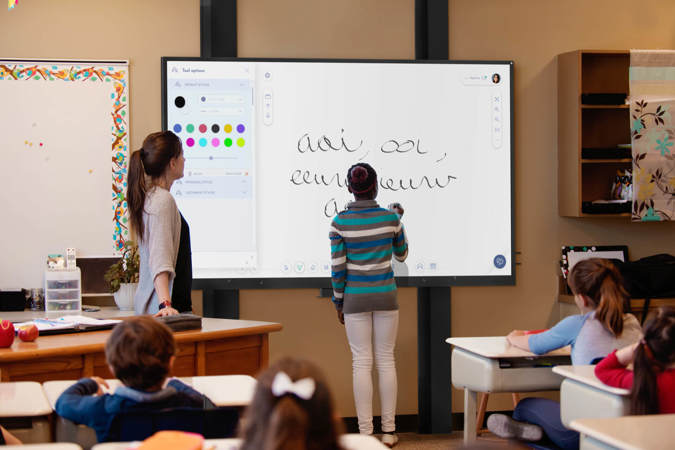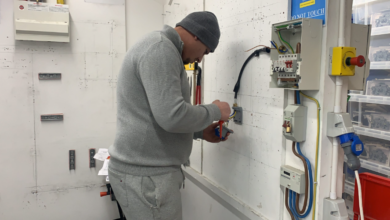The Interactive Whiteboard Classroom: Transforming Education for the 21st Century

Introduction
In today’s rapidly evolving educational landscape, traditional teaching methods are being supplemented—and often replaced—by innovative technologies that promote engagement, collaboration, and interactivity. One of the most significant advancements in this area is the interactive whiteboard (IWB). An interactive whiteboard classroom combines the conventional elements of a classroom with cutting-edge digital technology, offering a dynamic learning environment that enhances the educational experience for both teachers and students. This article delves into the concept of the interactive whiteboard classroom, exploring its features, benefits, applications, challenges, and future trends.
What is an Interactive Whiteboard?
An interactive whiteboard is a large display board that connects to a computer and allows users to interact with digital content using touch, gestures, or a stylus. The board can project various multimedia elements such as images, videos, and presentations, while also enabling real-time interaction and collaboration. With features such as handwriting recognition, annotation capabilities, and software integration, IWBs have become essential tools in modern classrooms.
Key Components of Interactive Whiteboards
- Display Surface: The board typically has a smooth surface that can be touched or written on with a stylus or finger. Some models offer a high-definition display that enhances clarity and visibility.
- Software Applications: IWBs come with specialized software that enables teachers to create interactive lessons, quizzes, and activities. These applications often include templates, resources, and tools for designing engaging content.
- Connectivity Options: IWBs can connect to various devices, such as computers, tablets, and smartphones, allowing seamless integration with different teaching materials and resources.
- Interactive Features: Many IWBs support multi-touch technology, enabling multiple users to interact with the display simultaneously. This feature fosters collaboration and group work among students.
- Audio and Visual Integration: IWBs often come equipped with built-in speakers and microphones, allowing for multimedia presentations and interactive discussions.
Benefits of the Interactive Whiteboard Classroom
The integration of interactive whiteboards into classrooms offers numerous advantages, fundamentally changing how teachers deliver lessons and students engage with content.
1. Enhanced Engagement
Interactive whiteboards captivate students’ attention by allowing them to participate actively in the learning process. Teachers can incorporate multimedia elements—such as videos, animations, and interactive simulations—that resonate with various learning styles. This engagement leads to better retention of information and a more enjoyable learning experience.
2. Improved Collaboration
IWBs promote collaboration among students. With multi-touch capabilities, students can work together on projects, solve problems, and engage in group activities directly on the board. This collaboration fosters teamwork and communication skills, preparing students for the demands of the modern workforce.
3. Real-Time Feedback
Teachers can provide immediate feedback using interactive whiteboards. During lessons, they can assess student understanding through quizzes and polls, making adjustments on the fly based on the responses. This ability to adapt instruction in real time enhances the overall learning experience.
4. Increased Accessibility
Interactive whiteboards can accommodate diverse learners by providing various ways to engage with content. Features like screen magnification, text-to-speech, and visual aids cater to students with different learning needs and abilities, ensuring that everyone has an opportunity to participate.
5. Seamless Integration of Technology
IWBs facilitate the integration of various educational technologies, such as tablets, laptops, and online resources. This connectivity enables teachers to incorporate up-to-date information and interactive content from the internet, making lessons more relevant and dynamic.
6. Encouraging Student-Centered Learning
The interactive whiteboard classroom promotes student-centered learning, where students take an active role in their education. By allowing students to interact directly with the board, they become co-creators of knowledge rather than passive recipients. This shift empowers students to take ownership of their learning process.
Applications of Interactive Whiteboards in Education
Interactive whiteboards have a wide range of applications in educational settings, making them versatile tools for teachers and students alike.
1. Dynamic Lesson Presentations
Teachers can use IWBs to create dynamic lesson presentations that incorporate multimedia elements, such as videos, animations, and interactive activities. This approach makes learning more engaging and helps clarify complex concepts.
2. Interactive Simulations
IWBs allow teachers to present interactive simulations that demonstrate scientific principles, mathematical concepts, or historical events. These simulations provide hands-on experiences that enhance understanding and retention.
3. Collaborative Projects
Students can work together on collaborative projects using IWBs, where they can brainstorm ideas, organize information, and create presentations as a group. This collaborative approach fosters teamwork and communication skills.
4. Quizzes and Assessments
Teachers can conduct quizzes and assessments directly on the interactive whiteboard. Students can answer questions using the touch screen, and teachers can instantly evaluate their understanding and adjust instruction accordingly.
5. Visual Learning Tools
Interactive whiteboards support various visual learning tools, such as mind maps, charts, and diagrams. Teachers can create visual representations of concepts, helping students better understand relationships and hierarchies within the content.
6. Remote Learning and Hybrid Classes
With the rise of remote learning, interactive whiteboards have become crucial in facilitating online education. They allow teachers to deliver engaging lessons to students at home, ensuring continuity in education during disruptions.
Challenges of Implementing Interactive Whiteboard Classrooms
While the benefits of interactive whiteboards are substantial, there are challenges that educators and institutions must consider when integrating this technology into classrooms.
1. Training and Professional Development
Effective use of interactive whiteboards requires adequate training for teachers. Many educators may feel overwhelmed by the technology or lack the necessary skills to integrate it into their teaching practices. Ongoing professional development is essential to ensure that teachers are confident and competent in using IWBs.
2. Cost and Budget Constraints
The initial investment in interactive whiteboards can be significant. Schools must consider not only the cost of the boards themselves but also the necessary software, maintenance, and training expenses. Budget constraints may limit the ability of some schools to implement this technology effectively.
3. Technical Issues
Interactive whiteboards may experience technical difficulties, such as connectivity issues or software glitches. These problems can disrupt lessons and frustrate both teachers and students. Having technical support readily available is essential to mitigate these issues.
4. Distraction Potential
While IWBs can enhance engagement, they can also pose distractions. Students may be tempted to play games or access non-educational content during lessons if not monitored effectively. Teachers must establish clear guidelines and expectations for appropriate use of the technology.
5. Balancing Technology and Traditional Teaching
There is a risk of over-reliance on technology, leading to a diminished emphasis on traditional teaching methods. Educators must strike a balance between utilizing interactive whiteboards and employing other teaching strategies to ensure a well-rounded educational experience.
Future Trends in Interactive Whiteboard Classrooms
As technology continues to advance, interactive whiteboards will likely evolve, influencing how education is delivered. Here are some emerging trends to consider:
1. Enhanced Interactivity
Future IWBs will likely feature even greater interactivity, including the integration of augmented reality (AR) and virtual reality (VR). These technologies can create immersive learning experiences that engage students on a deeper level.
2. Artificial Intelligence Integration
The incorporation of artificial intelligence into IWBs may provide personalized learning experiences for students. AI-driven software can analyze student responses and adapt lessons to meet individual needs, enhancing engagement and comprehension.
3. Increased Mobility
With the rise of mobile devices, future IWBs may focus on increased mobility and portability. Lightweight, transportable boards could allow teachers to move between classrooms, promoting flexibility and adaptability in various learning environments.
4. Cloud-Based Solutions
Cloud-based software solutions will enable seamless access to interactive content and resources from anywhere. This accessibility will allow teachers to collaborate and share resources more easily, fostering a global educational community.
5. Sustainability Initiatives
As schools become more environmentally conscious, the demand for sustainable technology solutions will grow. Future IWBs may focus on eco-friendly materials and energy-efficient designs, aligning with sustainability goals.
Conclusion
The interactive whiteboard classroom represents a significant advancement in educational technology, providing a platform for engagement, collaboration, and personalized learning. By combining traditional teaching methods with interactive technology, educators can create dynamic learning environments that cater to diverse student needs. While challenges exist in implementing interactive whiteboards, the benefits far outweigh the drawbacks. As technology continues to evolve, the potential for IWBs to transform education is vast.
In conclusion, adopting interactive whiteboards in classrooms is not merely a trend but a necessity for preparing students for the future. The benefits of engagement, collaboration, and enhanced learning experiences pave the way for a new era in education. As educators embrace this technology, they can inspire a generation of learners to explore, collaborate, and thrive in an increasingly complex world. The interactive whiteboard classroom is here to stay, shaping the future of education for years to come.




